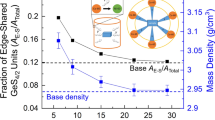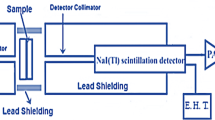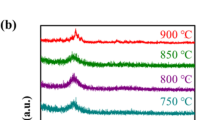Abstract
Understanding different bonding environments in various metal borides provides insight into their structures and physical properties. Polycrystalline aluminum diboride (AlB2) samples have been synthesized and compared both with a commercial sample and with the literature. One issue that arose is the relative ease with which boron-rich and aluminum deficient phases of aluminum borides can be presented in AlB2. Here, we report 27Al, 11B nuclear magnetic resonance (NMR) spectroscopy and first-principles calculations on AlB2 in order to shed light on these different bonding environments at the atomic level and compare the structural and electronic properties of the products of different preparations. Along with the aforementioned, the present study also takes an in-depth look at the nature of the 11B and 27Al nuclear spin–lattice relaxation recovery data for the AlB2 and other superhard materials. The nuclear spin–lattice relaxation has been measured for a static sample and with magic-angle spinning. The combination of NMR and band structure calculations highlights the synthetic challenges with superhard materials.








Similar content being viewed by others
References
Kayhan M, Hildebrandt E, Frotscher M, Senyshyn A, Hofmann K, Alff L, Albert B (2012) Neutron diffraction and observation of superconductivity for tungsten borides, WB and W2B4. Solid State Sci 14:1656–1659
Cheng X-Y, Chen X-Q, Li D-Z, Li Y-Y (2014) Computational materials discovery: the case of the W–B system. Acta Crystallogr C70:85–103
Cheng X, Zhang W, Chen X-Q, Niu H, Liu P, Du K, Liu G, Li D, Cheng H-M, Ye H, Li Y (2013) Interstitial-boron solution strengthened WB3+x. Appl Phys Lett 103:171903
Lech AT, Turner CL, Mohammadi R, Tolbert SH, Kaner RB (2015) Structure of superhard tungsten tetraboride: a missing link between MB2 and MB12 higher borides. Proc Natl Acad Sci USA 112:3223–3228
Nagamatsu J, Nakagawa N, Muranaka T, Zenitani Y, Akimitsu J (2001) Superconductivity at 39 K in magnesium diboride. Nature 410:63–64
Chung HY, Weinberger MB, Levine JB, Cumberland RW, Kavner A, Yang J-M, Tolbert SH, Kaner RB (2007) Synthesis of ultra-incompressible superhard rhenium diboride at ambient pressure. Science 316:436–439
Turner CL, Taylor RE, Kaner RB (2015) 10B and 11B NMR study of elemental boron. J Phys Chem C 119:13807–13813
Koumoulis D, Turner CL, Taylor RE, Kaner RB (2016) 11B NMR spectral and nuclear spin–lattice relaxation analyses of ReB2. J Phys Chem C 10:2901–2907
Turner CL, Zujovic Z, Koumoulis D, Taylor RE, Kaner RB (2017) 11B NMR study of WB2. J Phys Chem C 121(2):1315–1320
Burdett JK, Canadell E, Miller GJ (1986) Electronic structure of transition-metal borides with the AlB2 structure. J Am Chem Soc 108:6561–6568
Kopp JP, Barnes RG (1971) Nuclear magnetic resonance of 11B and 27Al in aluminum diboride. J Chem Phys 51:1840–1841
Eastman M (1999) Examples of Hartmann–Hahn match conditions for CP/MAS between two half-integer quadrupolar nuclei. J Magn Reson 139:98–108
Baek SH, Suh BJ, Pavarini E, Borsa F, Barnes RG, Bud’ko SL, Canfield PC (2002) NMR spectroscopy of the normal and superconducting states of MgB2 and comparison to AlB2. Phys Rev B 66:104510
Papavassiliou G, Pissas M, Karayanni M, Fardis M, Koutandos S, Prassides K (2002) 11B and 27Al NMR spin–lattice relaxation and Knight shift of Mg1-xAlxB2: evidence for an anisotropic Fermi surface. Phys. Rev. B 66:140514(R)
Pavarini E, Baek SH, Suh BJ, Borsa F, Bud’ko SL, Canfield PC (2003) NMR relaxation rates and Knight shifts in MgB2 and AlB2: theory versus experiments. Supercond Sci Technol 16:147–151
Burkhardt U, Gurin V, Haarmann F, Borrmann H, Schnelle W, Yaresko A, Grin Y (2004) On the electronic and structural properties of aluminum diboride Al0.9B2. J Solid State Chem 117:389–394
Choi YJ, Lu J, Sohn HY, Fang ZZ, Kim C, Bowman RC Jr, Hwang S-J (2011) Reaction mechanisms in the Li3AlH6/LiBH4 and Al/LiBH4 systems for reversible hydrogen storage. Part 2: solid-state NMR studies. J Phys Chem C 115:6048–6056
Sevastyanova LG, Gulish OK, Stupnikov VA, Genchel VK, Kravchenko OV, Bulychev BM, Lunin RA, Tarasov VP (2012) Structure and properties of solid solutions in the Mg–Al–B system. Cent Eur J Phys 10:189–196
Bielecki A, Burum DP (1995) Temperature dependence of 207Pb MAS spectra of solid lead nitrate. An accurate, sensitive thermometer for variable-temperature MAS. J Magn Reson A 116:215–220
Neue G, Dybowski C (1997) Determining temperature in a magic-angle spinning probe using the temperature dependence of the isotropic chemical shift of lead nitrate. Solid State NMR 7:333–336
Beckmann PA, Dybowski C (2000) A thermometer for nonspinning solid-state NMR spectroscopy. J Magn Reson 146:379–380
Jaeger C, Hemmann F (2014) EASY: a simple tool for simultaneously removing background, deadtime and acoustic ringing in quantitative NMR spectroscopy—part I: basic principle and applications. Solid State NMR 57–58:22–28
Fenzke D, Freude D, Frohlich T, Haase J (1984) NMR intensity measurements of half-integer quadrupole nuclei. Chem Phys Lett 111:171–175
Mann P, Klinowski J, Trokiner A, Zanni H, Papon P (1988) Selective and non-selective NMR excitation of quadrupolar nuclei in the solid state. Chem Phys Lett 151:143–160
Ronemus AD, Vold RL, Vold RR (1986) Deuterium quadrupole echo NMR spectroscopy II. Artifact suppression. J Magn Reson 70:416–426
Farrar TC, Becker ED (1971) Pulse and Fourier transform NMR: introduction to theory and methods. Academic Press, New York
Yesinowski JP (2015) Finding the true spin–lattice relaxation time for half-integral nuclei with nonzero quadrupole couplings. J Magn Reson 252:135–144
Harris RK, Becker ED, de Menezes SMC, Goodfellow R, Granger P (2001) NMR nomenclature, nuclear spin properties, and conventions for chemical shifts (IUPAC recommendations 2001). Pure Appl Chem 73:1795–1818
Bishop M, Shahid N, Yang J, Barron AR (2004) Determination of the mode and efficacy of the cross-linking of guar by borate using MAS 11B NMR of borate cross-linked guar in combination with solution 11B NMR of model systems. Dalton Trans 17:2621–2624
Bezhenar NP, Bozhko SA, Belyavina NN, Markiv VY, Shul’zhenko AA (2007) Кpиcтaлличecкaя cтpyктypa дибopидa aлюминия в кoмпoзитax КHБ, пoлyчeнныx peaкциoнным cпeкaниeм пpи выcoкиx дaвлeнияx Dopov. Nats Akad Nauk Ukr 9:77–81
Blaha P, Schwarz K, Madsen GK, Kvasnicka D, Luitz J (2001) WIEN2 k: an augmented plane wave + local orbitals program for calculating crystal properties. Tech Univ Wien, Austria. ISBN 3-9501031-1-2
Perdew JP, Burke K, Ernzerhof M (1996) Generalized gradient approximation made simple. Phys Rev Lett 77:3865
Tsiskarishvili GP, Lunström T, Tegenfelt J, Dolidze TV, Tsagareishvili GV (1991) Isotope effect in β-rhombohedral boron. In: AIP Conference Proceedings, pp 231–280
Lee D, Bray PJ, Aselage TL (1999) The NQR and NMR studies of icosahedral borides. J Phys Condens Matter 11:4435–4450
Sagalyn PL, Hofmann JA (1962) Nuclear magnetic resonance in metallic single crystals. Phys Rev 127:68–71
Shyu W-M, Das TP, Gaspari GD (1966) Direct and core-polarization contributions to the Knight shift in metallic aluminum. Phys Rev 152:270–278
Loa I, Kunc K, Syassen K, Bouvier P (2002) Crystal structure and lattice dynamics of AlB2 under pressure and implications for MgB2. Phys Rev B 66:134101
Massiot D, Farnan I, Gautier N, Trumeau D, Trokiner A, Coutures JP (1995) 71Ga and 69Ga nuclear magnetic resonance study of β-Ga2O3: resolution of four- and six-fold coordinated Ga sites in static conditions. Solid State NMR 4:241–248
Andrew ER, Tunstall DP (1961) Spin–lattice relaxation in imperfect cubic crystals and in non-cubic crystals. Proc Phys Soc 78:1–11
Jung JK, Baek SH, Borsa F, Bud’ko SL, Lapertot G, Canfield PC (2001) 11B NMR and relaxation in the MgB2 superconductor. Phys Rev B 64:012514
Lue CS, Tao YF, Su TH (2008) Comparative NMR investigation of the re-based borides. Phys Rev B 78:033107
Ambrosini B (1999) An nmr study of anomalous rare-earth and actinide intermetalic compounds. Doctoral Dissertation (Diss. ETH No. 13031), Swiss Federal Institute of Technology, Zurich
Woesner DE, Timkin HKC (1990) The influence of MAS on spin–lattice relaxation curves and nuclear spin excitation of half-integer spin quadrupolar nuclei in solids. J Magn Res 90:411–419
Yesinowski JP, Ladouceur HD, Purdy AP, Miller JB (2010) Electrical and ionic conductivity effects on magic-angle spinning nuclear magnetic resonance parameters of CuI. J Chem Phys 133:234509
Spokas JJ, Slichter CP (1959) Nuclear relaxation in aluminum. Phys Rev 113:1462–1472
Andrew ER, Hinshaw WS, Tiffen RS (1974) The anomalous 27Al NMR second moment in metallic aluminum. J Phys F Metal Phys 4:L215–L218
Wikner EG, Blumberg WE, Hahn EL (1960) nuclear quadrupole spin–lattice relaxation in alkali halides. Phys Rev 118:631–639
Van Kranendonk J (1954) Theory of quadrupolar nuclear spin–lattice relaxation. Physica 20:781–800
Acknowledgements
This material is based upon work supported by the National Science Foundation Grants DMR-9975975 (R.E.T.), DMR-1506860 (R.B.K.) and ShanghaiTech University Start-up Funding. The authors would like to thank Georgiy Akopov for assistance with flux growth.
Author information
Authors and Affiliations
Corresponding authors
Rights and permissions
About this article
Cite this article
Turner, C.L., Koumoulis, D., Li, G. et al. Synthesis and characterization of aluminum diboride products using 27Al, 11B NMR and ab initio studies. J Mater Sci 53, 3309–3322 (2018). https://doi.org/10.1007/s10853-017-1727-9
Received:
Accepted:
Published:
Issue Date:
DOI: https://doi.org/10.1007/s10853-017-1727-9




